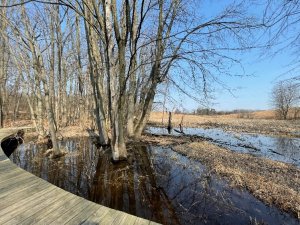Vernal Pools: Protecting, Monitoring, and Celebrating!
March 20, 2024
By Maddie Lukens, Park Interpreter
It’s that time that we have all been waiting for… vernal pool season! But what is a vernal pool? You may see a puddle of murky water in the woods and think nothing of it, but it just might be a unique wetland full of thriving biodiversity. Over 550 species of wildlife use vernal pools in the Northeastern US. This specific type of wetland might be the coolest you will ever come across. At first glance, a vernal pool might not seem like much, but take a closer look and you will find a world full of fairy shrimp, spotted salamanders, wood frogs and so much more!

And yes, I did say fairy shrimp, and no, they don’t have wings. These red-orange invertebrates are only 1-2 cm in length but are by far the easiest species to identify due to their uniqueness as a freshwater shrimp. Fairy shrimp can only be found in vernal pools and are considered an “indicator species”. This means that if there are fairy shrimp present, it is a vernal pool, but not all vernal pools contain fairy shrimp. Like many vernal pool species, the egg masses of fairy shrimp have adaptations that allow them to withstand the dry season and will hatch in freezing temperatures and rain. Once you see a fairy shrimp, they will become your favorite invertebrate species!
Vernal pools provide critical habitat for many rare amphibians, macroinvertebrates, reptiles, and plant species in Michigan. But what makes a vernal pool so different from any other wetland? Vernal pools are seasonal wetlands that are only wet for part of the year, usually due to naturally occurring flooding or snowmelt. Because these pools dry up for part of the year, they do not contain fish, a major predator for the rare species that call vernal pools their home. Not only are vernal pools critical for wildlife, but they also provide important ecosystem services like groundwater recharge.

There are many threats to the health and survival of vernal pools as these ecosystems are extremely fragile and easily disturbed. Climate change, development, conversion to permanent ponds, and invasive species are just a few of the threats that impose danger to these critical habitats. The migration of salamanders occurs on the first day/night with temperatures above 40°F, rain, and a melted snowpack. But the effects of climate change have given us a complicated web of unpredictable minimum and maximum daily temperatures and changes in rainfall that can harm salamander migration and reproduction. The limited legal protection for vernal pools has allowed their destruction in favor of development and converting them into permanent ponds with fish. With continued development and human disturbance, invasive species have taken root in many vernal pool ecosystems, making it difficult for our Michigan native species to survive.
So, we must work to protect these special wetlands, but how can we? The current wetland laws regarding vernal pools are not enough to properly protect them and vernal pools are only legally protected in 11 states. Although many of us cannot change legal protection for these pools, what we can do is identify, map, and monitor existing vernal pools. With the help of the Vernal Pool Patrol, a community science project started by the Michigan Natural Features Inventory, anyone can learn how to map and monitor a vernal pool. Mapping and monitoring our local vernal pools is crucial in knowing how climate change is affecting these fragile ecosystems, and how we might be able to help mitigate these affects.

Here at the Huron-Clinton Metroparks, we are working hard to spread awareness, ecological knowledge, and a passion for these beautiful seasonal wetlands and the rare species that inhabit them. Interested in seeing a vernal pool for yourself and what all the fuss is about? Luckily there is no shortage of vernal pools in Michigan, and you need not venture far. Many of our Huron-Clinton Metroparks are home to some exceptional vernal pools! These metroparks include, but are not limited to, Stony Creek Metropark and Oakwoods Metropark. Just remember to always stay on trail and respect your surrounding ecosystem. If you are feeling extra inspired and want to get involved with mapping and monitoring vernal pools, be sure to check out the Vernal Pool Patrol!
Be sure to check out “Ephemeral”, a short film created by the Michigan Nature Association (MNA) about the wonders of vernal pools.
Sources:
https://vtecostudies.org/wp-content/uploads/2020/03/Indicator-Species-ID-Sheet-1.pdf
https://vernal-pool-patrol-mnfi.hub.arcgis.com/
https://www.michigan.gov/egle/newsroom/mi-environment/2022/05/31/vernal-pools
https://www.youtube.com/watch?v=vdJDe3bA7j8
